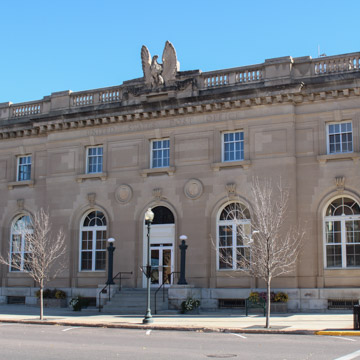The northeastern South Dakota city of Watertown was founded in 1879 as a rail terminus for the Chicago and North Western Railway. It prospered as a transportation hub and grew into a regional commercial center. During the early twentieth century, there was a movement to build new, freestanding post office buildings, and South Dakota was no exception. Post offices were constructed in Yankton (1906), Watertown (1909), Mitchell (1910), Huron (1912), and Rapid City (1913), all designed in the Beaux-Arts classical style favored by the supervising architect of the U.S. Treasury, James Knox Taylor.
Watertown’s Classical Revival post office was identical to that in Yankton, completed three years prior. The two-story building sits on a stone foundation and is clad in limestone. The ground-floor features large, round-arched windows (the glass itself was replaced at a later date), while the upper story contains smaller, square windows with four-over-eight sashes. Classical detailing includes keystones on the round-arched windows, bracketed sills on the upper windows, dentils, a rooftop balustrade, and a large eagle sculpture on the roofline above the round-arched main entrance, located in the center bay on the front (west) elevation.
A 1933 addition on the rear facade features a compatible design with similar materials and classical detailing. In the 1970s, the post office moved to a single-story brick building about a half a mile east on Kemp Avenue. Since that time, the original building has housed a variety of professional offices.

